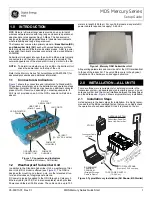
RTX 1000H series user manual
K0297 Issue 2
3-4
•
Installations outdoors for liquid or saturated gas service may require
insulation and heat tracing to prevent freezing.
•
For installations where the transmitter is more than 1.8 m (6 feet) from
the tapping, the impulse piping must be supported to prevent sagging
and vibration.
•
Impulse piping must be located in protected areas or against walls or
ceilings. If routed across a floor, protective coverings or kick plates must
be used. High temperature piping or equipment should be avoided.
•
Appropriate pipe sealing compound rated at the design piping
temperature must be used on all threaded connections. When making
threaded connections between stainless steel fittings, Loctite PST
Sealant is recommended.
3.7
The Transmitter Pressure Connections
The recommended connection uses a two-valve manifold connected between
the transmitter and the process pressure. Before connecting the transmitter
remove the protection caps and carefully inspect the sealing face and threaded
bore of the connection for damage.
Liquid service connections (Figure 3-3a)
Liquid measurement connections should be made to the side of the process
line to avoid deposits of sediment. The transmitter should be mounted beside
or below the connection so that gases vent into the process line.
Gas service connections (Figure 3-3b)
Gas measurement connections should be made to the top or side of the
process line. The transmitter should be mounted beside or above the
connection allowing any liquid to drain into the process line.
Steam service connections (Figure 3-3c)
Steam measurement connections should be made to the side of the process
line. The transmitter should be mounted below the connection so that the piping
remains filled with condensate. Live steam must not come into contact with the
transmitter; to prevent this the lines should be filled with water or condensate.
















































